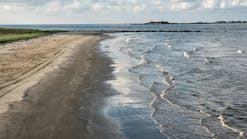Williams Ranch is a Master Planned community located in the unincorporated Castaic area of Northern Los Angeles County, California. Lying just north of Six Flags Magic Mountain, the development will provide 497 new homes and open space in the growing Santa Clarita Valley. However, with the current state of stormwater regulations and design requirements such as Low Impact Development (LID), developing a project of this magnitude and scope can be very challenging.
From a drainage standpoint, the site lies within the Santa Clara River watershed, which has approximately 1,634 square miles of tributary drainage area and discharges to the Pacific Ocean near the Ventura harbor. Given the project’s proximity to the Santa Clara River, which is listed as an impaired waterway under section 303(d) for Ammonia, Nitrate + Nitrite, Chloride, and Fecal Coliform, the drainage design had to include stormwater control measures that address these additional water quality objectives.
Alliance Land Planning and Engineering took on the task of developing a plan that would meet the numerous water quality and flow requirements. Their plan divided the site into 5 main drainage basins and 135 sub-drainage areas. Using the 85th percentile storm, which equaled 1.01 inches of rainfall, the Water Quality flow was 24 CFS and the retained volume came out to 560,134 CF.
Additional hydrologic and hydraulic analyses for the 2, 5, 10, 25, and 50 – year storms were conducted per the requirements outlined in the LACDPW Hydraulic and Hydrology manual to identify potential drainage impacts from hydromodification. These analyses revealed the need to attenuate flows up to 125.57 CFS and volumes up to 557,132 CF of stormwater.
To meet the LID requirements for the project, infiltration of accumulated stormwater within the drawdown time would be key. Fortunately, the site geotechnical investigation revealed an average infiltration rate of 2.9 in/hr, which meant that infiltration was technically feasible. Now, they needed an infiltration system that could mitigate a water quality flow of 156 CFS and volume of 560,000 CF.
Initially, they considered large diameter CMP and plastic arched chambers as options for the largest of the three infiltration systems. However, since LACDPW would inherit this system for maintenance, they decided to go with a system that would be durable, safely accessible, and easy to maintain. After a few meetings between the Developer, Contractor, LACDPW, and Precon Products, the system was changed to StormPrism EQ® (SPEQ®), a modular, precast stormwater system manufactured by Precon’s NPCA (National Precast Concrete Association) Certified Plant in Simi Valley, CA.
SPEQ® utilizes an assembly of modular precast pieces surrounded by separate wall elements that can be configured in endless to store stormwater. The modules are comprised of an 8’ X 16’ deck and four tapered legs that come in either single or stacked configurations.
The single configuration uses an 8’ X 16’ slab to form the bottom and is available with internal heights ranging from 3’ to 7’. The stacked configuration, which comes in internal heights from 8’ to 14’, flips the single module and then places a matching piece on top of the other, while aligning the legs with a pocket connection.
Since SPEQ® system uses a separate wall element to create the system volume, nearly all modules are the identical, which allows for a simple, fast installation, with little chance for mix-ups and having to redo things.
The SPEQ® system for Williams Ranch was comprised of a stacked system with an internal height of 11’. A total of 400 Modules (800 pieces) and 120 wall elements created a rectangular footprint of 164’ X 324’ and provided an infiltration volume of 565,316 CF including the rock bedding material.
After staging a few hundred module and wall pieces on site in August 2021, Precon Products and subcontractor R&R Pipeline began installation in September. The simple design and relatively low pick weights allowed for placement of the concrete elements with a large excavator and loader with a fork attachment. Soon, the install crews were averaging the placement of 61 pieces per day, which amounted to about 38,000 CF of volume per day.
As mentioned above, system maintainability was a big consideration for LACDPW in approving the use of the StormPrism EQ® system. SPEQ®’s large internal voids, flat floor, easy access, and clear visibility throughout the system were big selling points that convinced County Staff this was the right system. Of special importance was the system’s flat floor, which simplifies maintenance operations, eliminates trip hazards, and allows anyone to move around the system freely. Further, the use of columns instead of walls, allows for clear site lines throughout the entirety of the system, which creates a safer environment for workers to conduct maintenance operations.
With any infiltration system, it is especially important to keep sediment out of the gravel base and subgrade to allow for long-term performance. Despite how robust upstream pre-treatment may be, suspended materials will always find their way into any storage system and these materials can quickly destroy the performance of an infiltration system. With this in mind, Precon devised a fabric-covered basket for the SPEQ® system that filters the stormwater before it infiltrates into the ground. The fabric, which can be removed, washed, and reused, is made from a woven polymer designed to capture fine sediment. As the final piece of the treatment train, the filter baskets will keep sediment in the SPEQ® modules where it can be evacuated during periodic maintenance.
Working closely with the Developer and Contractors, Alliance put together an appropriate LID plan to mitigate hydromodification and meet water quality requirements on a challenging site. The treatment train approach, including the SPEQ® system, not only met the regulatory requirements, but was cost-effective and provided a safe, accessible structure that can be safely and easily maintained.
Editor's Note: Scranton Gillette Communications and the SGC Water Group are not liable for the accuracy, efficacy and validity of the claims made in this piece. The views expressed in this content do not reflect the position of the editorial teams of Water & Wastes Digest, Water Quality Products and Storm Water Solutions.







